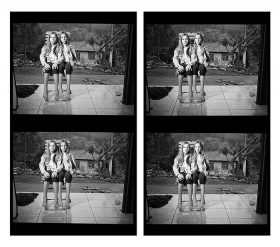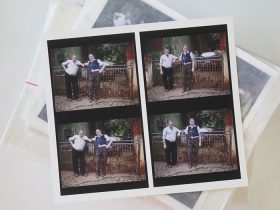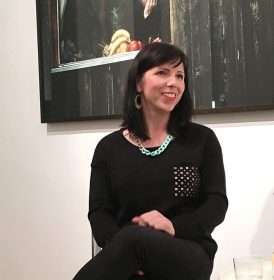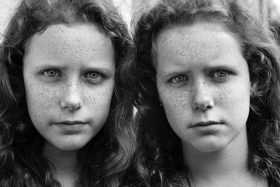Photo Portraits by Noga Shtainer
Noga Shtainer often travels with her camera in tow, for her photography project “Home for Special Children” in the Ukraine, for instance, or for “Twins” in Brazil. Shots from the latter project have been available for purchase from the art vending machine since 1 April 2016 (further information on our website). The photographer has lived since 2010 in Berlin, where I met her two years ago (I wrote about that encounter in a blog post in May of 2015).
The fact that Noga Shtainer is a photographer is itself accidental. She set out to become an actress. But she didn’t pass the entrance auditions for the WIZO School of Art in Haifa and was encouraged instead to apply for a photography class. The deadline for submitting an application portfolio was only two days away, however. So she simply handed in an envelope stuffed with photos and claimed that they were pictures she had taken of her half-sister. In fact, they were photographs from a family album, showing Noga Shtainer herself as a young girl. The trick was successful and Noga Shtainer was accepted at the age of 15 into the WIZO School of Art. Thus began her career as a photographer.
Photo portraits by Noga Shtainer are distinguished by their commitment and intensity. You can see this in the series “Twins – Duo Morality”. The similarity between two genetically identical people, and the simultaneous desire of the onlooker to differentiate between them, provoked Shtainer’s curiosity. In Israel she had already begun through photography to register the inequalities present in things that are apparently the same. In 2010 she pursued an unlikely trail into the dark history of Nazi ideology’s racial fanaticism: in Cândido Gódoi in southern Brazil, the unusually high density of twins supposedly has a connection to experiments by Josef Mengele. The town consists predominantly of German and Polish immigrants and their descendants who settled in southern Brazil during the First World War. Mengele allegedly lived and practiced medicine in the area in the 1960s, passing undetected under an assumed name. He had carried out brutal medical trials on Jewish prisoners at Auschwitz, including numerous barbaric experiments on twins. He may then have used the results in a variety of treatments on his patients in Brazil. According to some reports, this was why an unusual number of identical twins were born in that region. This story cannot be proven historically nor is there adequate evidence of genetically manipulated pregnancies in Cândido Gódoi. The many blond, blue-eyed pairs of twins, however, gave and continue to give new life to the Mengele Myth, still spurring the imagination of authors, filmmakers, and journalists today.
When Noga Shtainer arrived in Cândido Gódoi, she first needed to go in search of her models, since twins don’t always make appearances together. A period of intense investigation, going door-to-door and zealously polling neighborhoods, led Noga to find 50 pairs of twins who were prepared to be photographed.

Tamara and Samara, 2010, from the series “Twins: Duo Morality”, custom-made print for the art vending machine; Jewish Museum Berlin, photo: Noga Shtainer
Noga Shtainer’s intention to get to the bottom of this story became secondary to the artistic statement she was making. In the foreground of the series we see the twins in their residential environment, in the backyard or on the terrace: they look almost identical but on closer examination of the photographs one begins to distinguish between them. I caught myself, while observing the pictures, getting excited every time I noticed a difference between a pair of twins. Sometimes it’s the hair, the figure, perhaps a slight variation in the nose or eyes, or a little birthmark. It trains one to look more closely and to see more detail, to compare the surroundings, the position of both people in the image, and perhaps even to question their relationship to one another. As those portrayed become more familiar to the observer, the apparent conformity disappears as one recognizes that each twin is an individual.

Norbert and Nelson, 2010, from the series “Twins: Duo Morality”, custom-made print for the art vending machine; Jewish Museum Berlin, photo: Claudia Rannow
For the art vending machine in the permanent exhibition of the Jewish Museum Berlin, Noga Shtainer embarked on an experiment, showing her work in an unusual format. Normally she presents her work on a scale large enough to cover the whole wall, which would of course not have been feasible for the rather compact vending machine with its art treasures. But she took up the challenge and is showing her work here on a proportionately smaller scale, and at the same time doubled up: two copies of four versions of each pair of twins (appropriate enough given the theme). When one looks for instance at the pair of twins called Nelson and Norbert as they search with their Wilhelmine mustaches for the right position to stand in at the garden fence, the autographed pictures seem to contain entire little stories.
Incidentally, after her lucky break getting into the Haifa academy, Shtainer did in fact photograph her half-sister. For twelve straight years she took a picture of Ella on every Shabbat for her series “Near Conscious”. The intense photographs that emerged show a young girl growing up. In the meantime, Noga Shtainer is now by one of the most renowned galleries in Israel and had shows in Berlin as well through the middle of last February of her series “Wagenburg” and “Near Conscious.” As an article in the Jewish-German newspaper Jüdische Allgemeine about her latest photo project suggested, we will certainly be hearing more about Noga Shtainer.
Jihan Radjai is herself astonished at the similarities between her nieces, who are also twins, and she curated Noga’s show at the Berlin gallery Podbielski Contemporary.
Further information about Noga Shtainer on her website www.artnoga.com and on the website of the gallery Podbielski Contemporary.

